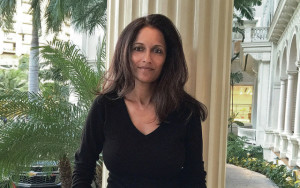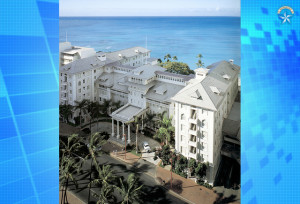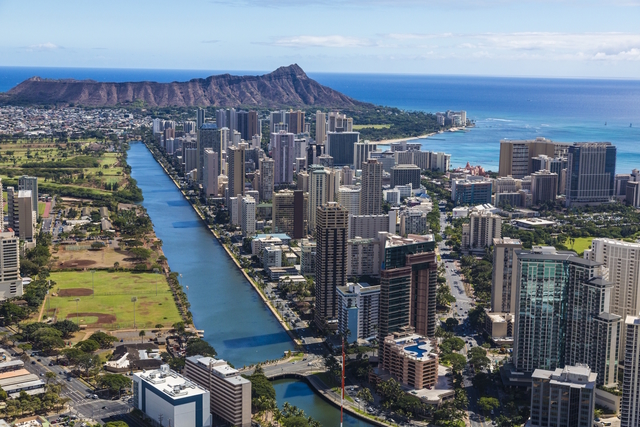Discover Waikiki’s architectural gems
As a child growing up in India, Purnima McCutcheon was a dreamer whose imagination was fueled by old temples, mosques, forts and palaces.
“I was born in Hyderabad but raised in Mumbai and traveled around the country a lot with my family,” she said. “Some of those buildings were centuries old, and I thought they were spectacular. I visualized being part of those historical scenes. Also, as a classical Indian dancer, I’ve always had a keen awareness of space and environment. Architecture has been the perfect career for me because I’m able to combine my interests in art, history and physics.”

COURTESY ERIC MCCUTCHEON
Purnima McCutcheon
Today McCutcheon is a project architect with Group 70 International; a member of the American Institute of Architects, Honolulu Chapter’s board of directors; and co-chairwoman of the volunteer committee of architects and architectural historians that has organized a guided walking tour of Waikiki as part of the 10th annual Architecture Month observance in April.
The two-hour tour will focus on eight sites. Docents will be at each site to explain their architectural significance.
“Waikiki plays a key role in Hawaii’s history and economy,” McCutcheon said. “The tour will show how Waikiki’s architecture and infrastructure have contributed to its development as a world-renowned resort.”
The “First Lady of Waikiki” — the Moana Surfrider, a Westin Resort & Spa — opened as the Moana Hotel on March 11, 1901, with 75 rooms in a six-story wooden structure that its architect, Oliver Traphagen, called “Colonial Style adapted for the tropics.”
Well-heeled guests arrived at a porte-cochere marked by six Ionic columns and flanked by colonnades adorned with fleur-de-lis. Design highlights also included ocular windows, decorative railings and graceful colonettes. Two six-story concrete wings, adding 150 rooms, were completed in 1917. Their symmetry, elaborate window casings with pediments and wide, low-pitched, hipped roofs reflect the Renaissance Revival style popular at the time.

MOANA SURFRIDER, A WESTIN RESORT & SPA
A bird’s-eye view of the grand “First Lady of Waikiki,” the Moana hotel.
“In the mid-1930s and the mid-1950s, the Moana underwent major ‘modernizations’ that stripped it of most of its distinctive features,” said Virginia Murison, lead architect for the $50 million, 20-month restoration that culminated with the hotel’s grand reopening in March 1989. “Still, the original 1901 building and the 1917 wings were placed on the National Register of Historic Places in 1972. The contemporary ‘Surfrider’ wings on the hotel’s Diamond Head and Ewa sides were added in 1952 and 1969, respectively.”
During the tour, Murison will be stationed at the Moana to share more insights about that elegant Waikiki landmark.
Another highlight will be the 2-mile-long Ala Wai Canal, which was constructed of stone and concrete between 1921 and 1928. Added to the state Register of Historic Places in 1992, it was designed to divert runoff away from the beaches, drain mosquito-breeding marshes and provide fill to reclaim 625 acres of land.
Lucius E. Pinkham proposed the idea for a canal in 1906, when he was the territory of Hawaii’s president of the Board of Health. In a report to the board, he described “a great lagoon” that would “create a quite marvelously beautiful, unique district, a Venice in the midst of the Pacific.” Paving the way for construction of the canal was one of his primary accomplishments as territorial governor from 1913 to 1918.
“The Ala Wai is the mauka (toward the mountains) boundary of Waikiki today,” McCutcheon said. “Over the years, Waikiki has become visually dense with buildings. The canal’s bridges, tree-lined sidewalks, peaceful waters and large, open space add an aesthetic element.”
Also of note is St. Augustine Church Waikiki, which, built in 1962, is the latest of several Catholic churches that have occupied its Ohua Avenue site over the past 150-plus years. Docents will point out its Gothic-style gable roof and interior arches, which resemble hands clasped in prayer.

COURTESY MASON ARCHITECTS INC.
Stained glass at St. Augustine Church depicts its namesake.
A magnificent 36-by-70-foot stained-glass window above the main entrance honors St. Augustine’s namesake and patron saint. Ten steeply pitched, triangular stained-glass windows on both sides of the church depict biblical themes and important events in Roman Catholic history in Hawaii.
“Architecture tells the story of a place at a certain time in the same way as a book or a painting,” McCutcheon said. “A building’s design, materials and technology provide clues about prevailing trends, beliefs and lifestyles.”
Buildings typically incorporate the technology of the period in which they were constructed. For example, jalousie windows became popular in Hawaii in the late 1940s and 1950s.
“They were prevalent in homes throughout the islands that were built during that era, including walk-up apartments in Waikiki,” McCutcheon said. “The more you get to know a building, the deeper your connection to it, which can lead to advocacy for historic preservation and thoughtful, appropriate design in the future.”
If you go …
AIA Honolulu’s Historic Waikiki Walking Tour
>> Meeting place: To be given out upon booking
>> Day: Saturday
>> Time: Between 8 a.m. and 12:30 p.m. Tour times are set on a first-come, first-served basis by advance online reservation and prepayment.
>> Cost: $15 per person. No refunds will be given; confirmed participants are welcome to invite someone else to attend if their plans change.
>> Phone: 628-7244
>> Email: contact@aiahonolulu.org
>> Website: aiahonolulu.org
Notes: Participants should be mobile and able to walk 1 mile without difficulty. Bring water and snacks and wear comfortable shoes, sunscreen and hats.
Other Architecture Month events
Admission to these events is free, and advance registration is not required.
>> April 14, 21, 29: AIA’s Hawaii Island Section will screen “Alejandro Aravena: The Power of Synthesis” and “Olmsted and America’s Urban Parks”; this double feature shows how architecture can positively transform communities.
>> April 14: 6 p.m., Donkey Mill Art Center, 78-6670 Mamalahoa Highway, Kona
>> April 21: 5:30 p.m., W.M. Keck Observatory headquarters, 65-1120 Mamalahoa Highway, Waimea
>> April 29: 5:15 p.m., Hawaii Innovation Center at Hilo, 117 Keawe St., Hilo
>> April 27: 6 p.m., “Urbanized,” a documentary about the issues and strategies behind modern urban design, Center for Architecture, 828 Fort Street Mall, Suite 100
>> April 29: 5-8 p.m., Several Honolulu architecture companies invite the public to see works in progress and meet the architects who are spearheading them. A list of participating firms is at aiahonolulu.org.
———
Cheryl Chee Tsutsumi is a Honolulu-based freelance writer whose travel features for the Star-Advertiser have won several Society of American Travel Writers awards.


